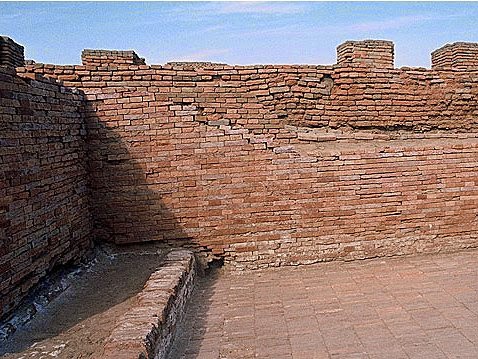Mohenjo Daro Picture
Photography (mostly by Dr. M. Y. Jamro in 1996).
We Sindhis are proud of our old heritage. It's the legacy of Mohen-jo-daro that symbolizes our vibrant civilized past from the times when people in many parts of world were living in caves. The recent survey into civilization suggests that Mohen-jo-daro civilization is perhaps the first ever civilization where the concept of Architecture, civil engineering and luxurious life style flourished not less than current standard.
It is a fact that indoor plumbing did not arrive in modern societies to any extent until the 19th century and also urban planning has still not been adopted much to that period of Mohen-jo-daro date in history. What we find in the ancient city of Mohen-jo-daro is anomalous indeed. This city in the Indus Valley was built on a grid system about 4,500 years ago, obviously planned out and drawn up before the first brick was laid. It had houses, some with indoor plumbing, a granary, baths, an assembly hall and towers all made out of standard size bricks. The streets were about eight to ten feet wide on average, and were built with well-engineered drainage channels. Mohen-jo-daro was successively destroyed and rebuilt at least seven times. Each time, the new cities were built directly on top of the old ones. Flooding by the Indus is thought to have been the cause of destruction. Mohen-jo-daro is a remarkable construction, considering its antiquity. The city was divided into two parts, the Citadel and the Lower City. Most of the Lower City is yet uncovered, but the Citadel is known to have the public bath, a large residential structure designed to house 5,000 citizens and two large assembly halls.
Other side of the outlet drain
opening of great bath. A view from inside the drain opening
Another view of wide street. On the right hand side the ruins are unexcavated.
A view of an narrow pathway of a street in Mohen-jo-daro (similar to modern bricks-path) and covered drainage system through street.
A closer look into a long straight drain
Two-story water wells. One in each block of flats/houses.
Top view inside a water well. A downward spiral staircase is visible that was used to clean the water and surface by professional cleaners. Even today, same style water wells are in daily use in rural areas of Sindh (protective iron cage is placed on the surface by authorities).
Photography (mostly by Dr. M. Y. Jamro in 1996).
We Sindhis are proud of our old heritage. It's the legacy of Mohen-jo-daro that symbolizes our vibrant civilized past from the times when people in many parts of world were living in caves. The recent survey into civilization suggests that Mohen-jo-daro civilization is perhaps the first ever civilization where the concept of Architecture, civil engineering and luxurious life style flourished not less than current standard.
It is a fact that indoor plumbing did not arrive in modern societies to any extent until the 19th century and also urban planning has still not been adopted much to that period of Mohen-jo-daro date in history. What we find in the ancient city of Mohen-jo-daro is anomalous indeed. This city in the Indus Valley was built on a grid system about 4,500 years ago, obviously planned out and drawn up before the first brick was laid. It had houses, some with indoor plumbing, a granary, baths, an assembly hall and towers all made out of standard size bricks. The streets were about eight to ten feet wide on average, and were built with well-engineered drainage channels. Mohen-jo-daro was successively destroyed and rebuilt at least seven times. Each time, the new cities were built directly on top of the old ones. Flooding by the Indus is thought to have been the cause of destruction. Mohen-jo-daro is a remarkable construction, considering its antiquity. The city was divided into two parts, the Citadel and the Lower City. Most of the Lower City is yet uncovered, but the Citadel is known to have the public bath, a large residential structure designed to house 5,000 citizens and two large assembly halls.
In Picture; Mohen-jo-daro:
showing equal spaced pillars, walls, well-balanced foundations. Stupa or Watch
Tower room in the central location at a highest place (being mud-plastered by
authorities to protect from heavy monsoon rain). A portion of Great Bath visible in the
bottom-left corner of the above picture whereas the bottom-mid section contains underground channels of
water to fill and empty the Great Bath.
Mohen-jo-daro has a planned
layout based on a grid of streets, with structures constructed of bricks of
baked mud, sun dried bricks and burned wood. At its height the city probably had
around 35,000 residents. It had an advanced drainage system, a variety of
buildings up to two stories high and an elaborate bath area. Being an
agricultural city, it also featured a large well, granary, and central
marketplace. Perhaps most unexpected, it even had a building with an underground
furnace (hypocaust), possibly for heated bathing similar to those Baths built by
Roman.
Front view of Great Bath of Mohen-jo-daro.
Great Bath that was made of
fine quality brickwork and drains. The Great Bath was 40 feet long and 8 feet
deep, a huge public facility by any standards. The Great Bath was made watertight by the use of two layers of brick,
lime-cement and then finally sealed with bitumen (tar) to stop any water leakage. The bath included a
shallow section for children. It had channels to fill fresh water from river and
drain out in to downstream. It had quarter turn-steps into main area on either
sides other than main stairs in centre.
Side view of Great bath. Water
channels in the front and on the right hand side.
Great bath outlet, an inside
view; showing outlet channel for water to drain. It was at the brink of collapse
when I last visited in 1996.
It is to mention with a great
disappointment that officially Government of Pakistan withdrawn completely from
the protection project for a period of about 10 years due to lack of funds.
There was not even a single security person during that withdrawn period until
very recently in 2005-06 when UNESCO provided funds to save this wonderful
historical icon. This shows the intentions and the interest of Islamabad in the
preserving the best gift of the great Sindhi civilization.
 |
 |
Huge grain house-hold storage
pots with narrow opening at bottom.
Huge grain storage pots,
granaries, large residential building block and several assembly halls were also
on the upper level.
Rooms (or small barracks)
inside a house on Mohen-jo-daro. A water well is also visible (covered with a
protective disk by authorities).Another view of wide street. On the right hand side the ruins are unexcavated.
A view of an narrow pathway of a street in Mohen-jo-daro (similar to modern bricks-path) and covered drainage system through street.
A closer look into a long straight drain
Two-story water wells. One in each block of flats/houses.
Top view inside a water well. A downward spiral staircase is visible that was used to clean the water and surface by professional cleaners. Even today, same style water wells are in daily use in rural areas of Sindh (protective iron cage is placed on the surface by authorities).
It is a mystery that how an ancient culture of
which nothing is known,
not even their language, created this sophisticated city at a point in time many
thousands of years ahead of the curve? Civil engineers do not crawl out of
thatched-roof huts able to draw up plans for a complex urban environment. We
need to address the following question to archaeologists and historians:
1. Where are the cities that demonstrate the path of urban development, social and technical organization, leading to Mohen-jo Daro?
1. Where are the cities that demonstrate the path of urban development, social and technical organization, leading to Mohen-jo Daro?
2. How do you explain the sudden emergence of a complex society when the rest of
humanity was living primitively?
A computer generated 3D model
of the Great bath, its surroundings and over the top will soon be presented. Meanwhile, watch
the surroundings of bath inside out and imagine its construction from a civil
engineering and Architect point of view.
Indus Valley Civilization
|
|
|
| |












.jpg)
.jpg)
.jpg)












.jpg)
.jpg)

0 Comments